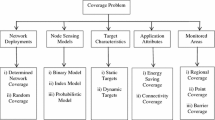Abstract
The progress of development on sensor networks has inspired many new applications. Some of these applications require the target to be observed by more than one sensors simultaneously. Sensor coverage, which reflects how well a sensor network is monitored by sensors, is an important measure for the quality of service (QoS) that a sensor network can provide. In this paper, we addressed the coverage problem from two different view points and referred to them as the worst-case and best-case coverage problems. Most existing works on these two problems assumed that the coverage degree is one (i.e. the target area falls within the sensing range of at least one sensor). In this paper, we address the k-coverage problem, where the coverage degree is a user-defined parameter k. This is a generalization of the earlier work where only k=1 is assumed. By combining geometric and algorithmic techniques, we establish optimal algorithms to solve the two variants of the k-coverage problem in polynomial time. An important extension of our study on the k-coverage problem was also proposed: the distributed algorithm for the problem. This helps in applying the proposed algorithm under more practical scenarios.











Similar content being viewed by others
References
Adriaens, J., Megerian, S., & Potkonjak, M. (2006). Optimal worst-case coverage of directional field-of-view sensor networks. In 3rd annual IEEE communications society on sensor and ad hoc communications and networks (SECON ’06) (Vol. 1, pp. 336–345).
Awerbuch, B., & Gallager, R. (1987). A new distributed algorithm to find breadth first search trees. IEEE Transactions on Information Theory, 33, 315–322.
Batalin, M. A., & Sukhatme, G. S. (2004). Coverage, exploration and deployment by a mobile robot and communication network. Telecommunication Systems, 26, 181–196.
de Berg, M., van Kreveld, M., Overmars, M., & Schwarzkopf, O. (1997). Computational geometry: algorithms and applications.
Han, G., Xu, H., Duong, T., Jiang, J., & Hara, T. (2011). Localization algorithms of wireless sensor networks: a survey. Telecommunications Systems, 1–18.
Huang, C., & Tseng, Y. (2005). The coverage problem in a wireless sensor network. ACM Mobile Networks and Applications, 10(4), 519–528.
Huang, C., Tseng, Y. C., & Lo, L. (2007). The coverage problem in three-dimensional wireless sensor networks. Journal of Interconnection Networks, 8(3), 209–227.
Huang, L., Xu, H., Wang, Y., Wu, J., & Li, H. (2006). Coverage and exposure paths in wireless sensor networks. Journal of Computer Science and Technology, 21(4), 490–495.
Kumar, S., Lai, T., & Barlogh, J. (2004). On k-coverage in a mostly sleeping sensor network. In Proceedings of MobiCom 04 (pp. 144–158).
Li, D., Wong, K., Hu, Y., & Sayeed, A. (2002). Detection, classification and tracking of targets in distributed sensor networks. IEEE Signal Processing Magazine, 19.
Li, X., Wan, P., & Frieder, O. (2003). Coverage in wireless ad-hoc sensor networks. IEEE Transactions on Computers, 52(6), 753–763.
Liu, J., Liu, J., Reich, J., Cheung, P., & Zhao, F. (2004). Distributed group management in sensor networks: algorithms and applications to localization and tracking. Telecommunications Systems, 26, 235–251.
Mao, G., Fidan, B., & Anderson, B. D. (2007). Wireless sensor network localization techniques. Computer Networks, 51, 2529–2553.
Megerian, S., Koushanfar, F., Qu, G., & Potkonjak, M. (2002). Exposure in wireless sensor networks: theory and practical solutions. ACM Journal of Wireless Networks, 8(5), 443–454.
Megerian, S., Koushanfar, F., Potkonjak, M., & Srivastava, M. (2005). Worst and best-case coverage in sensor networks. IEEE Transactions on Mobile Computing, 4(1), 84–92.
Meguerdichian, S., Slijepcevic, S., Karayan, V., & Potkonjak, M. (2001). Localized algorithms in wireless ad hoc networks: location discovery and sensor exposure. In Proceedings of MobiHoc 01 (pp. 106–116).
Mehta, D., Lopez, M., & Lin, L. (2003). Optimal coverage paths in ad-hoc sensor networks. In Proceedings of IEEE ICC 03 (pp. 507–511).
O’Rourke, J. (1998). In Computational geometry in C.
Tang, S., Mao, X., & Li, X. Y. (2009). Optimal k-support coverage paths in wireless sensor networks. In PERCOM ’09: proceedings of the 2009 IEEE international conference on pervasive computing and communications (pp. 1–6).
Vashney, P. (1996). Distributed detection and date fusion.
Wan, P., & Yi, C. (2006). Coverage by randomly deployed wireless sensor networks. IEEE Transactions on Information Theory, 52, 2658–2669.
Xing, G., Wang, X., Zhang, Y., Lu, C., Pless, R., & Gill, C. (2005). Integrated coverage and connectivity configuration for energy conservation in sensor networks. ACM Transactions on Sensor Networks, 1, 36–72.
Yen, L., Yu, C., & Cheng, Y. (2006). Expected k-coverage in wireless sensor networks. Ad Hoc Networks, 4, 636–650.
Zhou, Z., Das, S., & Gupta, H. (2004). Connected k-coverage problem in sensor networks. In Proceedings of ICCCN 04 (pp. 373–378).
Author information
Authors and Affiliations
Corresponding authors
Additional information
This project is supported by the Fundamental Research Funds for the Central Universities XDJK2013C007.
Rights and permissions
About this article
Cite this article
Fang, C., Zhang, P., Huang, W. et al. Multi-covered path in wireless sensor networks. Telecommun Syst 54, 19–33 (2013). https://doi.org/10.1007/s11235-013-9713-2
Published:
Issue Date:
DOI: https://doi.org/10.1007/s11235-013-9713-2




